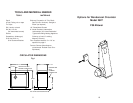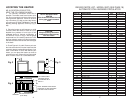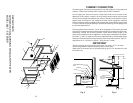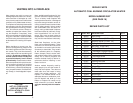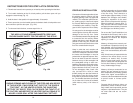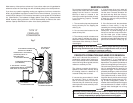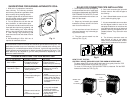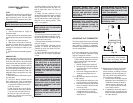
CAUTION:
NOT ALL FIREPLACES
ARE SUITABLE FOR
INSTALLATION OF A COAL
HEATER.
REPAIR PARTS
AUTOMATIC COAL BURNING CIRCULATOR HEATER
MODEL NUMBER 2827
(SEE PAGE 16)
KEY NO. PART NO. DESCRIPTION QTY.
1 89062 Door Knob 1
2 83005 Machine Screw (10-24 x 1/2) 1
3 83005 Machine Screw (10-24 x 1/2) 1
4 83093 Spring Latch 1
5 83244 Nut (Kep, 10-24 Plain) 1
6 67968 Cabinet Door Frame 1
7 86191 Thermostat Linkage Adjuster 1
8 85381C Control Panel Plate 1
9 89142 Thermostat Knob 1
10 67725 Cabinet Front 1
11 67967 Cabinet Left Side 1
12 21593 Hinge Support 1
13 83833 Hinge Clip 1
14 67966 Cabinet Top 1
15 67743 Thermostat Assembly 1
16 21063 Back Brace 2
17 67514 Cabinet Back 1
18 89065 Door Hinge 4
19 67969 Cabinet Door 1
REPAIR PARTS LIST
6 15
Many people may wish to convert an
existing fireplace to heater use. Usually,
safe connection of stovepipe to a ma-
sonry chimney requires more effort than
connection to a prefabricated chimney.
The fireplace must be closed and sealed
at the damper in the flue. Good sealants
are high temperature caulking, ceramic
wool, and furnace cement. Always re-
member to inspect the masonry chim-
ney and fireplace. If necessary, clean
the flue and smoke shelf before begin-
ning your installation. Install the heater
into the chimney so that the system can
be dismantled for cleaning and inspec-
tion.
Before deciding to convert your fire-
place or existing chimney, keep in mind
that older fireplaces and their chimneys
are unsafe. They must be structurally
sound, and the flue liner must be in good
condition. Do not use a chimney if it is
unlined (should have a tile clay liner
to protect brickwork), have it relined
professionally. Clearances to combus-
tibles are explained in the previous sec-
tion on masonry chimneys. If you have
any questions regarding the condition
of the chimney, consult a qualified engi-
neer, competent mason, certified Chim-
ney Sweep, or knowledgeable inspec-
tor.
Many prefabricated fireplaces fall into
the "zero-clearance fireplace" category.
This is a factory metal fireplace with
multilayered construction. It is designed
to provide enough insulation and/or air
cooling so that the base, back and sides
can be safely placed in direct contact
with combustible floors and walls. Al-
though many prefabricated fireplaces
have been tested by nationally recog-
nized organizations for use as fire-
places, they have not been tested to
accept heaters. In fact, their use as such
may void the manufacturer's warranty.
Steel-lined fireplaces, on the other
hand, can be used with heaters. These
units use a 1/4-inch fire box liner and an
air chamber in connection with 8 inches
of masonry to meet code. They contain
all the essential parts of a fireplace,
firebox, damper, throat, smoke shelf,
and smoke chamber. Many of them look
exactly like a masonry fireplace and
must be checked closely for above re-
quirements before installing a coal
heater into them.
Another method frequently used by
some people is to vent the heater di-
rectly into the fireplace. This does not
meet code since the heater is being
vented into another appliance - the
fireplace. This method should not be
attempted because combustion prod-
ucts will deposit and build up in the
firebox or fireplace. Be certain not to
install a hazard in you house. You will
void your warranty with this installa-
tion.
VENTING INTO A FIREPLACE




